Cleveland, Ohio: The Clearest Distillation of America
A preserved past and slow progress towards a promising future are rewriting decades of decline. Oh, and it's beach city that loves meat. There's lots of meat.
My first evening in Cleveland I wandered The Flats near downtown, watching the Goodyear Blimp fly over Progressive Field as the sunset danced off the skyline and peopled filled downtown for a July 4th fireworks show. It was the most American setting I’d seen in years. Not in some patriotic way, it just had a classic nostalgia. There are certain things that feel American at their core, and this scene had all of it. Baseball, skyscrapers, fireworks, and the goddamn Goodyear Blimp. But it was everything else too — 100-year old art deco architecture mixed with lifeless new builds and remnants of an industrial past rotting alongside the Cuyahoga River (famous for catching fire 14 times) that is in a decades long restoration period. Everything felt perfectly American — the good, bad, and the ugly — there’s history, decline, and resilience here. And it’s the reason Cleveland feels like the single best distillation of our country.
Like so much of the Rust Belt and Midwest, Cleveland is a city that helped build this country only to be left by two thirds of its population and become an afterthought to the rest of the nation. It is one of the poorest cities in the country with consistently high rates of violent crime (always take these stats with a grain of salt) and longstanding urban decay. All of which is comically at odds with the city’s motto – Progress & Prosperity. But as of late, people are coming back (the population loss is now a trickle not a torrent), the crime rates are on a consistent decline (a 46% decline in homicides since the new Mayor took office in 2022), and the decay is being reimagined (Edgewater Park is now the place to be). When you get to meet the people here, and see some of the ongoing revitalization projects firsthand, that motto really is a through-line for where this city sees itself in the not too distance future. And I have to say, I’m a believer.
How fitting then that my first stop in Cleveland was the welcoming Prosperity Social Club in Tremont. It’s an old-school tavern, originally named after and owned by the Dempsey family (from 1938-2005), but in continuous operation since the beginning, with only 3 different owners. Little has changed since it became the Prosperity 20 years ago – vibe and décor remain intact, down to the original tables and chairs. I arrived at 6 p.m. on Friday, a perfect spot for my first sip of beer and a meal after a long travel day.
I ordered a P.O.C. Pilsener which, depending on who you ask, stands for the Pride of Cleveland, Pleasure on Call, or Pilsner of Cleveland (I like them all). In a new city, you must always worship at the altar of the regional cheap beer. It is a divine experience and a great way to ingratiate yourself into the culture. However, that’s murky here. The original Pilsener Brewing Company brewed P.O.C. and made into the blue collar staple of the city for the 20th century. But the company was sold a few times before P.O.C was officially out of circulation in 1984. Luckily Double Wing Brewing Co. started their own version of the original in 2019. Despite it not being the mass produced cheap beer I hoped for, it hits on a 90 degree day with 80% humidity (I never did find the true regional budget beer).
Prosperity has an eclectic clientele where you might see 3 generations of a family enjoying brunch at 11 a.m. and rowdy karaoke for the 21+ crowd 10 hours later. It is a place for all of Cleveland, and the menu reflects that. They offer standard hits like burgers & fries and fish fry; traditional Hungarian and Polish (large immigrant populations here) dishes like stuffed cabbage rolls, pierogis, and potato pancakes; and even vegan options like tofu wings and heart of palm fish fry. First generation immigrants and dietary restricted Gen Zers can both get down at Prosperity. Hell, all three of the people I met up with in Cleveland suggested we rendezvous here. That’s about as good an endorsement as a bar can get.
Before meeting up with Leslie and her partner, Brian, we had been chatting for a few weeks. She serendipitously stumbled upon my little Substack and works for the tourism board. She was quick to offer tips and connections, and offered a great introduction to the city on my first night. They are Cleveland to the core, born and raised in the city, and here to stay.
They were a library of facts about the bar, neighborhood, and city, plus unending anecdotes about the rock and punk history of Cleveland. Brian played in the Unknown, Beatnik Termites, and Bluto’s Revenge, all staples of the Cleveland scene. With the former, he opened up for Green Day on the Dookie tour in ’94, an infamous Blossom Music Center show that saw the lawn torn to shreds. Stories of the Dead Boys and REM were peppered in amongst tales of the scene then and now.
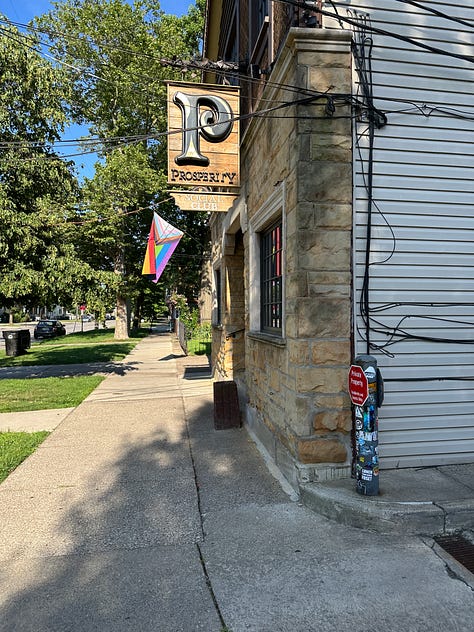
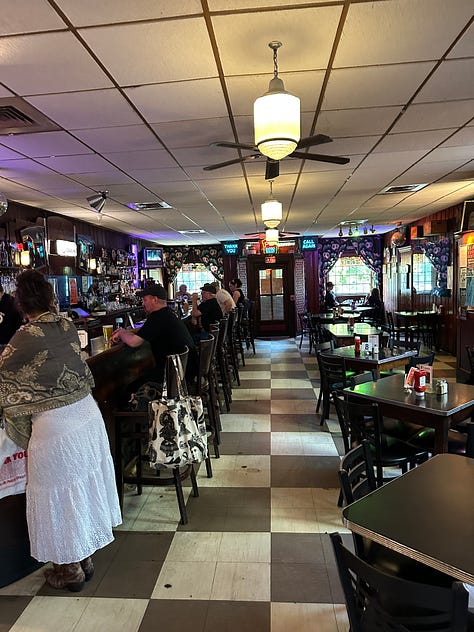
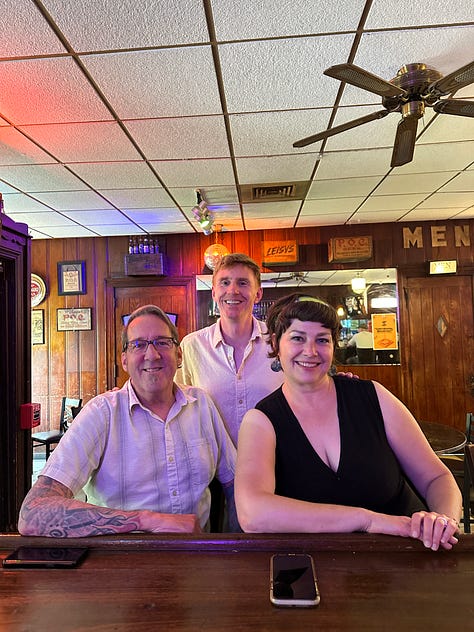

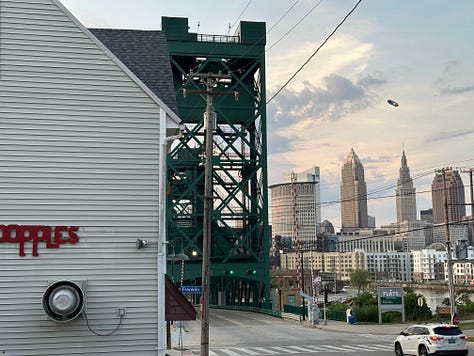

Grabbing dinner and drinks with me on a Friday basically meant Leslie worked overtime (give the woman a raise!), and on a holiday no less. Prior to landing at This Is Cleveland she had worked in restaurants and bars, co-authored a book about the history of Cleveland beer, and was, along with Brian, owner of the original Cleveland Brew Bus, a company offering brewery tasting tours. That track record made her not only overqualified to speak with me, but an ideal fit for a tourism board in a city pushing themselves as a destination.
Meanwhile, Brian played in bands crucial to the underground scene here, making a name for himself in a bonafide rock and roll city. Oh, he’s also a retired firefighter of 27 years and former bus mechanic for Cleveland municipal schools. The passion for the city and music scene was explicit in conversation, without ever being mentioned. They’re lifers that know how to enjoy the fruits of their city with the same gusto in which they rep it. We had several rounds with ease before splitting ahead of the July 4th festivities.
Leslie & Brian’s firsthand accounts of the music scene gave me context for the rock and roll heritage the city had. I obviously knew that the Rock Hall is here, and yes, I knew Ian Hunter’s, Cleveland Rocks. But I didn’t know that the song (which was reintroduced and popularized on the Drew Carey show by the President’s of the United States of America), was written in 1979. Or Hunter’s inspiration, “goes back to the old days when people used to make fun of Cleveland. Cleveland was ‘uncool’ and LA and NYC were ‘cool’. I didn’t see it that way. Lotta heart in Cleveland.” That quote rang true throughout my visit.
And it only takes a cursory search to see the rock roots go deeper than that – with 50s disc jockey, Alan Freed, popularizing the term “Rock and Roll” on his radio show and putting it firmly into the mainstream consciousness. In the 60s, the Agora Ballroom became a premier club to play in the US, bands like ZZ Top and the Talking Heads grew to national prominence shortly after playing there. They even became the first ever venue with an in-house recording studio. Yes, Cleveland is a rock and roll city through and through.
When I finally visited The Rock Hall on Sunday, the rock culture hit me right in the face. Not the museum, but the unknown band on a festival stage just outside it. It was 5 teens, fronted by a girl. The crowd was minimal, but they were rippin’. I pulled up as they finished a song, she told us they had one more – it was by Rage Against the Machine. I perked up but expected a hit like “Bulls on Parade.” To my delight, they went with a deeper cut, “Freedom.” And they crushed. Most of their friends in the front new the words too. It’s hard to imagine this city not faring well when that’s what you encounter from the youth.
The museum itself was somewhat of a disappointment. Don’t get me wrong, the collection is insane and covers everything. But that’s also part of the problem. When I see Prince, Jimi Hendrix, and Chuck Berry’s iconic guitars, Beatles’ clothing, Michael Jackson’s glove, and Neil Young handwritten lyrics, all back-to-back in an hour, it all starts to lose meaning. None of it has a chance to breathe or standout. It’s sensory overload to the point that I wasn’t awed by much. I suppose the same could be said of any museum. Regardless, if you’re in Cleveland, you should still go.
Having split from Leslie and Brian, I headed towards downtown, but the city operated in that small town way, by mostly shutting down for the July 4th fireworks. It seemed every spot I wanted to hit – Hotz Cafe, Hooples, Little Johnny’s, B & G Tavern, and Happy Dog, all closed to let their employees have the day with friends and family. I love the family holiday vibe, except that as an outsider, I was hopeful those bars would be my family for the evening. But I take what the city gives, and it handed me a full 8 hours of sleep without a hangover.
I started my next morning with a drink from Duck Rabbit Coffee and a walk to the West Side Market. My breakfast? A $4 Italian Sausage Sandwich from Frank’s II. Why? Because that price is insane and Cleveland is the most tubed-meat friendly city in the country. This would be my first of 3 meals that day containing some form of sausage. Not by plan, by the sheer overabundance on every menu I crossed.
This was a good stroll to check off tourist must-sees. The West Side Market, in operation since 1912, is your typical indoor market monstrosity – wide like a warehouse with high arched ceilings, and a dozen rows of vendors, clogged with gawkers and tourists. Most stalls served meat, foreshadowing how many interpretations of the tube steak this city would offer. But a visitor can only do so much with raw provisions on vacation. So, I window shopped and contemplated some meat sticks for the road.
In 85 degree heat I crossed over the shadeless Hope Memorial Bridge to see the Guardians of Traffic statues and make my way downtown. If you wondered why Cleveland’s MLB team was renamed the Guardian’s, it’s cause of these 43-feet sandstone behemoths. The Art Deco guardians each hold a different vehicle in hand, from stagecoach to truck, to “typify the spirit of progress in transportation,” according to the bridge’s engineer, Wilbur Watson. Weird and cool.
Now downtown, I checked out the Cleveland Arcade, built in 1890 and considered the first indoor shopping center in the US, and financed by some of the city’s wealthiest residents, including John D Rockefeller. While today the Hyatt Hotel operates the towers and upper floors, there is still retail and food courts on the lower two floors. Despite the reality of now being a sad mall and odd hotel, the original structure is a beauty. It’s a giant indoor courtyard with a domed, 100-ft high skylight that spans 300-ft, filling the center with light, while shops line the edges of the ringed balconies. If every mall from my childhood had these marble floors, brass elevator doors, and intricate balconies they might still be around today. It’s food for thought.

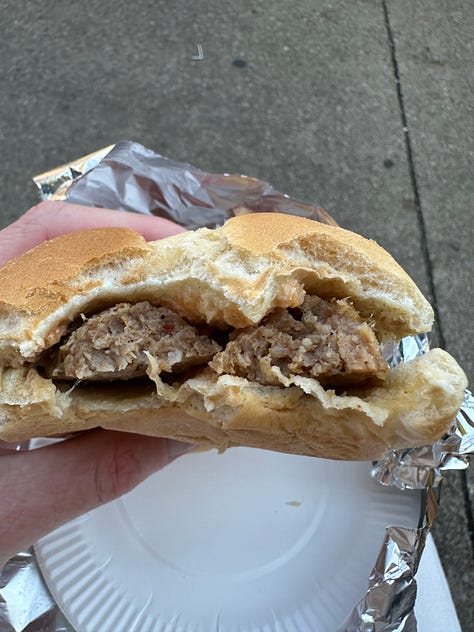
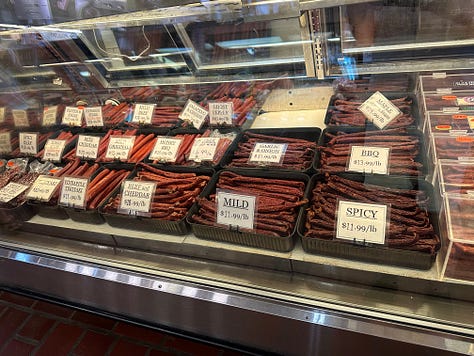


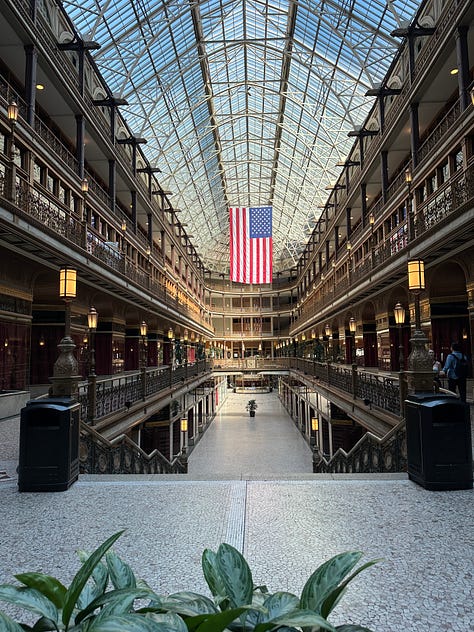
My second point of contact was Chuck – drummer in Brian’s band Bluto’s Revenge, script writer & movie director (check out Madtown), former college runner, and current HS XC coach. Not one to shy away from knocking a few back, he was a natural fit as tour guide. And he took the idea of Second Rate Cities very literally, much to my excitement, and offered to take me on a running bar tour of the city.
We began in Edgewater Park, an epic stretch of Lake Erie beachfront surrounded by green park space, with the Cleveland skyline as a backdrop. For anyone who’s not been to Cleveland, I guarantee your thoughts of it as a Midwest afterthought will be turned upside down when you get the full view of Cleveland masquerading as a sexy summer destination. My brain struggled to process it. White sand beaches, clear water, and a skyline backdrop? How?
We cruised for about a mile before landing at our first stop, the Whiskey Island Still.
This is a love-hate kind of spot for me. On one hand, the place is a Jimmy Buffet Bar which makes me want to peel my skin off. It’s 1 p.m. and the house band is already playing Margaritaville and hundreds of people are lapping it up (Chuck noted this was nothing compared to nighttime). On the other hand, it’s an outdoor bar on a beautiful beach… on a hot summer day… people are already day-drunk … and we’re in the fucking Rust Belt?
With apologies to Chuck’s and my punk past, Whiskey Island rocked. We may have only kept it to a beer before moving along, but truthfully, I’d have been fine to get sloppy there in my running shorts, watching the day slip away. And now I sound like I’m trying to recreate Buffet’s lyrics. Damn it. He really did tap into something, didn’t he? Who am I?
We zigzagged off the beach, across the Old River via the Willow Road Bridge, through the West Bank Flats, and mostly vacant streets, to the Harbor Inn Café. It’s the most hyped of the Cleveland dives, with the distinction as the longest continuously running bar in Cleveland (established 1895). Its location meant that, decades ago, it was a prime spot for dock and factories workers after their shift. It was mostly dead at 2:15 p.m. on a Saturday, but our bartender, Amanda, brought the attitude that gave it life. She was so Cleveland it almost felt staged. And Chuck was there to prime her.
After incessantly ribbing us for being runners, she started in on our appearance – skinny, red, and sweaty - while simultaneously sharing about her family, and scattering in random facts. Now, if you don’t know, Cleveland stretches east to west on the lake, meaning there’s not a north side of town, only Lake Erie. So, you’re either from the Eastside or West.
After she mentioned she was from Parma, which is rarely acknowledged as it’s South of the city core, Chuck quipped, “So do you consider that East or West side then?”
Her eye roll felt like the twist of a knife, “If you have to ask, go fuck yourself.”
Amanda is the best. I only wish I could’ve seen her in her true element, late at night in a packed, disorderly Harbor Inn Cafe.
Continuing along the flats, Chuck dug deep on the running and race history in Cleveland. He discussed a brief world record from the Cleveland 10K in 1996 (a 27:20 from Joseph Kimani, which Kimani then broke a mere 2 months later), a race in which he helped with course set up. He jokingly credited his cone placement. He opined that the world is cone-centric, cones keep the world in order. He was half joking, but I could sense some roundabout truth. We noticed a few cones on our route, directing traffic or barring pedestrians from off-limits areas. Once you pay attention, you realize they’re everywhere, like the rubber bands and duct tape of our cities, just enough to keep us from sliding into total disarray.
We hit Brick & Barrel for a beer before passing Hooples, which was still closed. We crossed the Cuyahoga on the Columbus Road Bridge and went back up into Tremont for our final stop at Edison’s. This is a classic neighborhood joint, with pizza available next door from Lil Ronnies. With 5 miles, 3 beers, and a great inner Cleveland tour under our belt, I was feeling good and ready to knock a few back. Chuck said he wasn’t sure if he felt great or awful, the true sign of a successful day.
Between a few slices and pints, I heard more about Chuck’s punk past, like trying to get booked at CBGB’s in the early 90’s. Their booking line was only open for an hour each day and he could never get through. His solution? Send a care package to the venue, with his number. This was a gesture so unheard of that he got a call back and an eventual gig opening for Henry Rollins. His first encounter with Rollins was seeing him digging through trash behind the venue. Apparently Rollins liked to bring New York trash back to LA and make art with it. New punk facts for ya, friends!
Our hang ended with Chuck’s teenage son picking us up and dropping me off as they headed home to pack for a Chuck-chaperoned cross country team camp-out. Had he turned down the beers on our run, it would have made sense. But I’d already learned that this city was filled with good-hearted party people, so it was only natural that Chuck towed that line despite having real obligations.

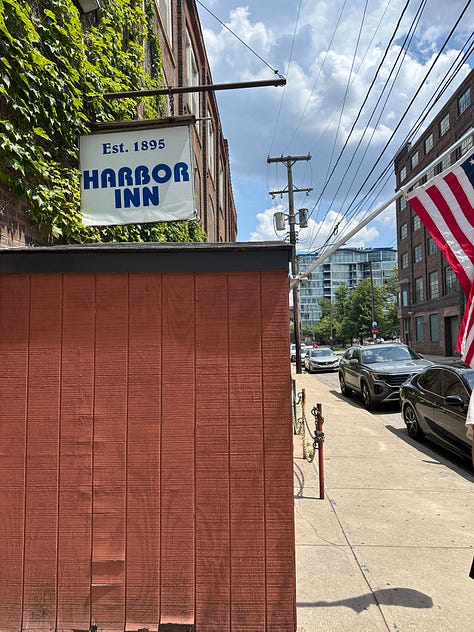
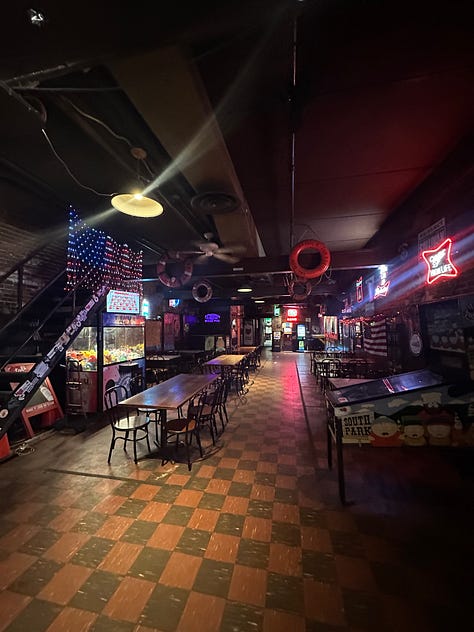
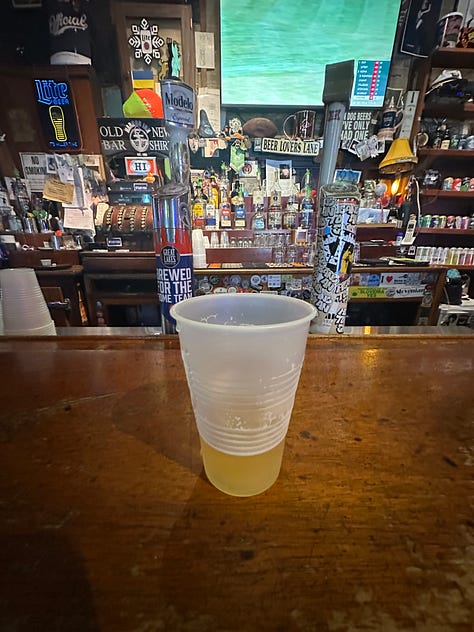
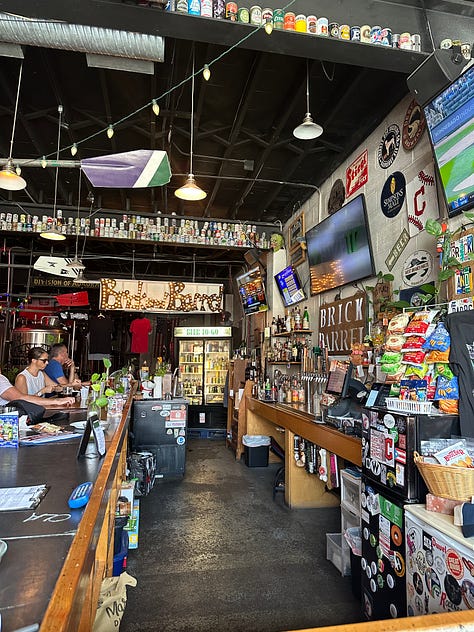
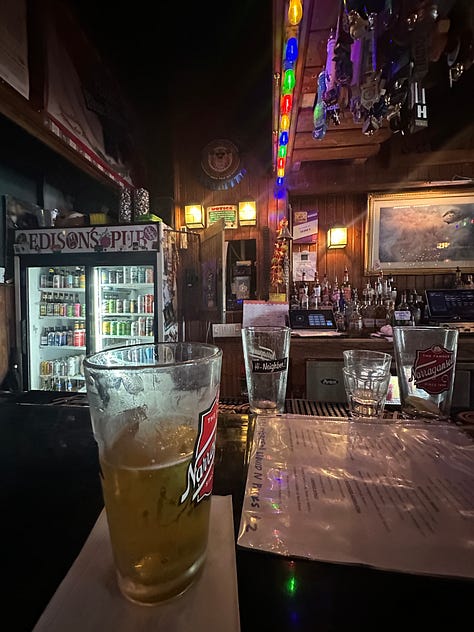
I rolled right back to Tremont that evening to explore the delights of the Rowley Inn, a food forward neighborhood bar. While they close at the very modest hour of 11 p.m. on weekends, it’s worth noting they open at 7 a.m. for your drinking (and eating, read: daily brunch!) needs. They also happen to be famous for sitting caddy corner from the “A Christmas Story” house. You can sit at the bar, eat a Polish Boy, and stare leisurely at leg lamp. And that’s exactly what I did.
Oh, what’s a Polish Boy? Besides my second meal of the day containing meat in tubed form, it’s also the staple sandwich of Cleveland. It’s a Kielbasa (usually) in a bun topped with French fries, bbq sauce, and coleslaw. It’s a worthwhile regional sandwich that one must meet with an intense appetite.
Content and full, I made it to Hotz Café and it felt like home. It’s a corner building with the corner entrance (always a nice touch), and a brick facade. This bar is pure history, cheap drinks, and good vibes. Founded in 1919 and family run (currently in its 4th generation of family bartenders), it’s seen Babe Ruth, Lou Gehrig, and Ty Cobb pass through, as well as a pre-President Franklin D. Roosevelt.
Hotz is the joint you wish your neighborhood had. It has the finer touches of a true dive – the middle of the bar top is a glass-plated Hotz logo, backlit with a soft red light. There’s also shuffleboard and a juke box. It’s so neighborhood that two separate birthdays took place there that night. And low and behold, when it’s your birthday, you must wear a cone on your head and dance (was Chuck omnipresent?).
I knocked back gin and tonics and high life while talking to the bartender Sheila. She was one of two older women behind the bar, each working with the hustle equal to any 20 year old. Sheila is a 3rd generation bartender here, serving drinks for the past 27 years with no sign of stopping. Her husband’s grandfather started the bar, and the 4th generation bartenders? Well, those are her kids.
She told me she knew everyone’s name in the bar. And after seeing a loud man in an American flag cowboy hat, who might otherwise be considered a disturbance, lean over the bar and kiss her on the cheek, I believed it. Shortly after, a woman walked behind the bar, gave her a warm hug, and planted another on her cheek. Throughout the night she asked how everyone’s 4th of July was, getting answers like “Yeah, we rode the 4-wheelers. I’m a little sore. A lot hungover.” She kept our conversation going throughout the night too and twice placed an empty plastic cup upside down next to my beer, signifying a buy back.
Even the worst part of the bar — the blasting of new era pop-country music — wasn’t bad. Sheila kept coming back to me and apologizing —
“I’m sorry, we’re not a country bar, and not this country, it’s just one of these girls at the party has taken over the juke box.”
That she was embarrassed by it, and could sense my recoil, made the place that much more endearing. As with any spot of this caliber, I wanted to settle in and end my night here. But having been shut out of so many places the night before, I made my way to Parkview and Happy Dog.
Just as Hotz is an eternal classic, Happy Dog seemed to be the staple of the new era. It just had that vibe – it books cool local and occasional national acts, has a wild menu, and is chock full of artists and hipster types from the scene. It’s the bar that has the cool reputation and actually delivers. It felt like a place to hook up with a stranger, take a date, have your band play their record release show, or go see that band that’s eventually going to blow up (like King Gizzard playing here back in 2014). The bar here is a massive horseshoe, so there’s basically 360 degree seating, while the stage is just a sliver of space against the front wall, overlooking an open floor and tables.
I missed the music that evening, but the spot was still hoppin’. Without trying, I’d stumbled onto my third tubed-meat of the day, settling in at the bar with a beer and their ludicrous menu of 50 toppings for hot dogs. The most famous topping is also the dumbest — Froot Loops — but many others are super fun like pimento mac n cheese and Brazilian chimchurri sauce. My topping choices were an attempt at good health while ordering a hotdog drunk. Don’t ask me, drunk-brain does what it does. But actually, the combination of mustard, sliced cucumbers, diced tomatoes, and alien relish was perfect for a midnight snack.
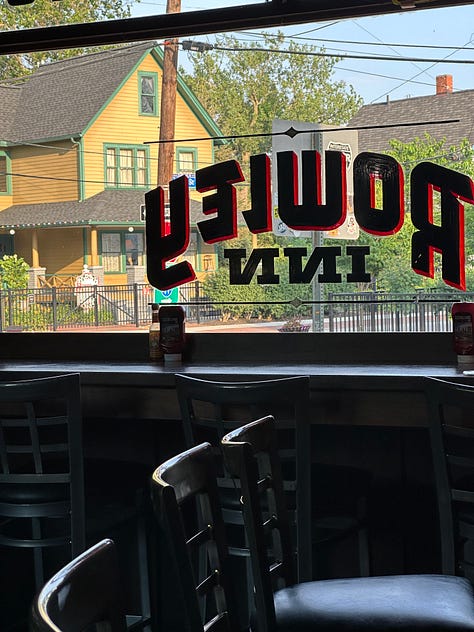
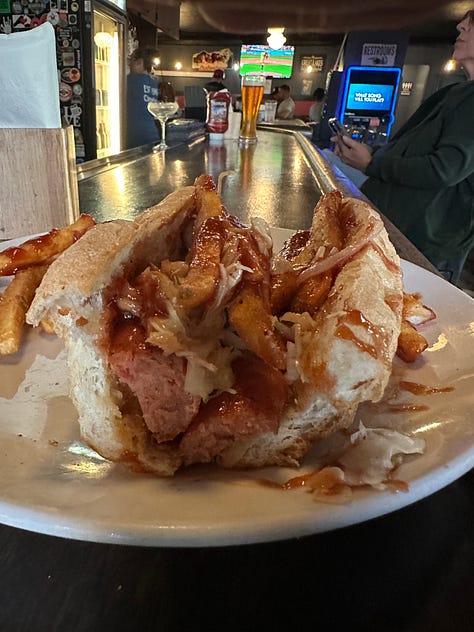
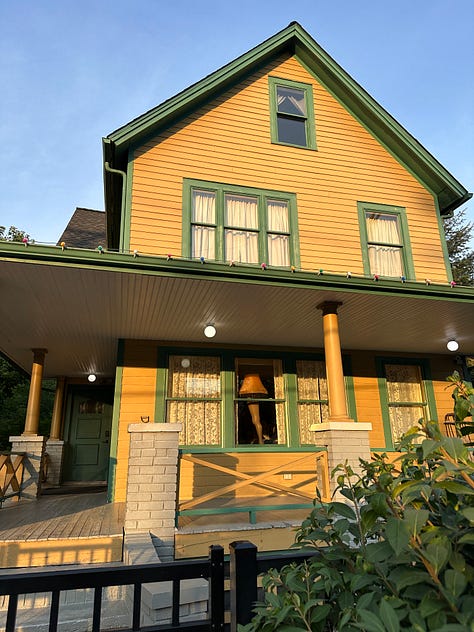

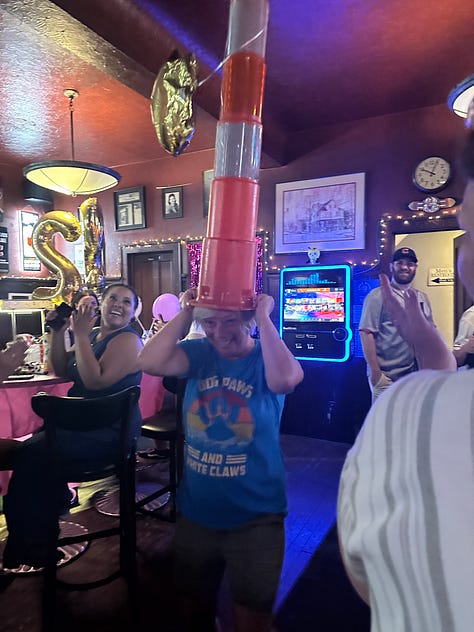
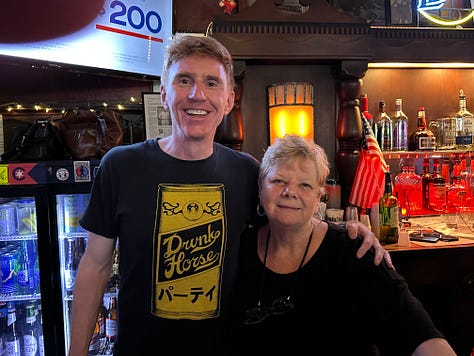
From eating drunk hotdogs alone at midnight to an illuminating noon brunch the next day with Phil Kidd, the perspective shift I had was literally night and day.
So, what praise can be heaped on Phil that hasn’t been lavishly doled upon him before? He is the personification of love for, and change in, Cleveland. With every personal encounter I had to this point, I felt a palpable connection to the city, and Phil was the full embody of it. Working at The Mayor’s Office of Capital Projects, he runs the Complete & Green Streets (CGS) program as well as trail projects for the City of Cleveland. He does everything from project management and grant writing, to project development and partner organization work. Broadly, his goals are to de-pave the city and repurpose unused or underutilized space for public use. Think making the city more sustainable & green (roughly 45,000 tress have been planted citywide since 2015, through a coalition of partners), and creating a pedestrian & bike friendly environment. He has a clear focus to create the change the city needs while preserving the past.
It should be noted that he’s working in the office of a mayor aligned with those goals. Justin Bibb is the young (just 38) black mayor of Cleveland, in the same city that had the first black mayor in US history (Carol B Stokes, 1967). While liberals across the country see Zohran Mamdani as the new hope in politics (this is not a slight, go Mamdani!), Cleveland elected their own homegrown agent of change back in 2021. And the city has had momentum since. Bibb has overseen a modernization of the mayor’s office, a 46% reduction in homicides, creation of alternative response models to emergency calls, land clean up and reuse, and neighborhood and waterfront revitalization and development.
Phil, originally from Western Pennsylvania, has been in Ohio for more than two decades, and in Cleveland the last 6 years. During the pandemic he started a blog, Every Street Cleveland, in which he intends to run, literally, every street in Cleveland and document it (he’s completed more than 1,000 miles of streets and over 60% of the goal). He groups his posts by neighborhood and details the runs noting history, current pain points, new developments, key businesses, prominent figures, and any other bit of intrigue. It’s a voluminous and growing body of work that touches on nearly everything within each section of the city.
100 years from now this will be the time capsule that people refer to when trying to understand what Cleveland was like in the early 21st century. It’s thousands of miles and moments in time stitched together by a single set of eyes, making a permanent memory of Cleveland. Who better then to take on reimagining the public spaces and streets of Cleveland than someone who’s spent time on every last one?
Prior to this, Phil had already cemented his status as a Rust Belt legend with his work in Youngstown, Ohio. Phil lived there for more than a decade, transitioning from a student to an activist and organizer in the city. Many evenings during his early days he could be found standing on a downtown corner holding a sign that said, “Defend Youngstown.” It was, at first, a mere slogan to help the city reignite its own self-worth, but it grew into a full-fledged marketing campaign. It led him to more civic engagement in the community, to start Youngstown Nation (a Youngstown gift shop selling all things Youngstown – both merch and made-in town items), to being hired by Mahoning Valley Regional Organizing Collaborative, and helping the city go from 18 to over 50 neighborhood organizations.
So yeah, grabbing Sunday brunch with Phil at Prosperity was eye opening. Eating pierogis, sipping a bloody Mary, and learning about Phil and his work in Cleveland simply energized me. During our conversation I kept thinking, “Man, every city could use a few Phil’s.” I later found out that the Chair of the Cleveland Planning Commission had said the same thing, “We need to figure out how to multiply you,” when referencing Phil. Yes, Cleveland is lucky to have the one and only. The OG.
Earlier that day I had run past the beaches of Edgewater Park and into the Lakewood neighborhood (as ritzy an enclave as you’ll find in any American city). On the way back I took a dip — my first ever Great Lake swim and a bucket list summer experience. The sand was soft and fine, and the water remarkably warm and clean (or at the very least, clear). I asked Phil about the beach and he dove into the history. The beaches used to be state run and neglected. Like any decaying city park there was a buildup of trash, glass and needles riddled the beach, and drugs use was the only regular activity, if you saw anyone at all. Chuck too had mentioned how he’d been running there for decades, miles of park all to himself, until one day it became a destination for all Clevelanders.
That day only came after the state turned management of the park over to Cleveland Metroparks in 2013. The first change was the notion that Cleveland could be a lakefront community. Then, after more than a decade of public involvement and volunteer efforts, city partnerships and development projects, Edgewater transformed into what I saw that weekend – an urban waterfront that everyone wanted to be part of.
Finishing brunch with Phil, I mentioned I was on my way to the Rock Hall. I was curious if he had any neighborhood recs for my last evening.
“Based on what I know about you, I think you should go East and check out Collinwood…
Wait, you know what? I have my bike on my car! Take my bike to the Rock Hall, afterwards you can ride the lakefront path, it’s 8-10 miles along the river straight to Collinwood.
I just moved over there, I’ll meet you and we can grab dinner. Plus, you’ll see the lakefront airport and why it’s such a waste of space.”



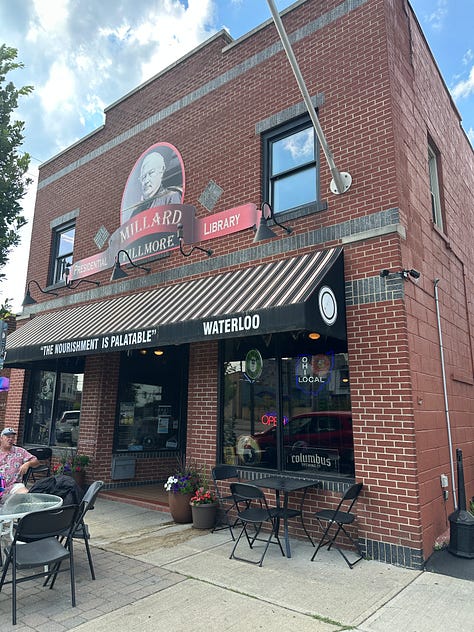

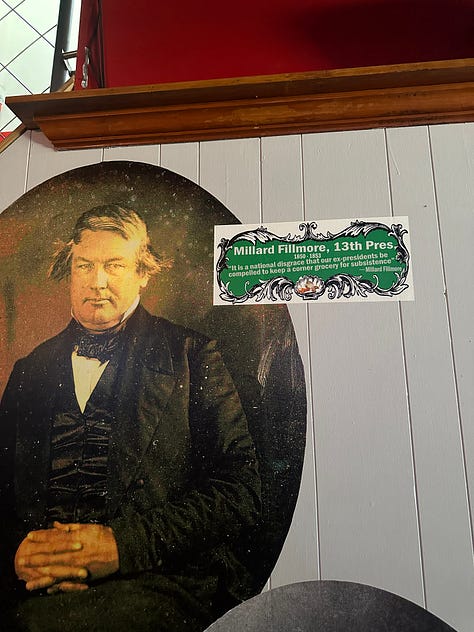

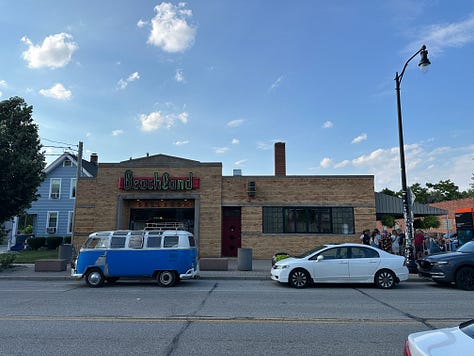

That’s just who Phil is. And that’s what I did. I rode the 9 miles sandwiched between Lake Erie and I-90, on Marginal Road. It’s one part bike path, one part seldom used road that looks at acres of misused prime real estate that might one day be reimagined in Phil’s vision – more public lakefront space that’s easily accessible. I rode through Bratenahl, a bizarre wealthy suburb, closed off from Cleveland by the freeway and lake. Up to that point I had ridden through a shadeless scene of deteriorating asphalt and concrete, with the freeway humming in my ear, but now I was enveloped by a tunnel of lush trees, springing from the manicured yards of sprawling mansions.
Eventually, the outstretched lawns and high, wrought iron fences of Bratenahl faded back to the more common Cleveland scene of vacant lots and corner stores. Some of this felt like modest living, but much of it felt depressed and lifeless. Though years behind the revitalization of neighborhoods like Tremont and Detroit-Shoreway, the seeds for rejuvenation have been planted in North Collinwood, on Waterloo Road.
While only a three block stretch, in area and surrounded by what appeared to be a languishing food desert, Waterloo does appear from the abandonment like a welcome oasis. There’s Doink’s Burger’s and Citizen Pie, a coffee shop, a record store, a vintage shop, and a tattoo studio. But most importantly, there’s three uniquely iconic spots on this strip – The Millard Fillmore Presidential Library, The Beachland Ballroom & Tavern, and the vacant lot at 15805 Waterloo Road.
The Millard Fillmore Presidential Library – This is actually a bar in “honor” of our 13th President who established the White House library, but who does not have a presidential library himself. And he still doesn’t. But he does have a bar full of presidential photos with fake quotes and cheap American flag banners. Serving some good local beers on draft, it’s a much needed watering hole in Collinwood. And while I never saw a food menu, a couple guys ordered hot dogs and I snuck myself onto the order before our bartender went back to boil them. Tubed meat anyone?
The Beachland Ballroom & Tavern – This venue has been bringing shows to this far-flung neighborhood for 25 years. In front of the tan brick façade with its elegant neon sign was a cobalt blue Volkswagen van parked out front, an image that transported me to another era. I would’ve stuck around all night had there been a show. Even without music that night, I could feel the magic emanating from the place, a venue that must lend itself memorable performances.
15805 Waterloo Road – This is just a vacant lot next to a mural that says “Kaboom.” It caught my eye but I didn’t think much of it. Turns out this spot is the former apartment of Danny Greene (Infamous Cleveland Mobster who helped give the city the title of Bomb City, USA). He was here when a bomb intended to kill him went off, destroying the home but leaving him with only minor injuries. That was in 1975, he died in 1977 (a car bombing), but the lot has remained a vacant ode to him.
Heading to the Airport the next day, and making small talk with my driver Pat, I mentioned being in Collinwood and seeing the mural. But of course, Pat grew up in Collinwood and shared his own slice of Cleveland history.
As a 7 year old kid he was walking down Waterloo when a friendly Danny Greene, who he’d never met, approached him with some money.
Kid, take this money and grab me a pack of smokes from the corner store and bring them back here, he said. And get yourself something too.
Pat did as he was told, grabbing the cigarettes, plus a pop and bag of chips for himself. He returned to Danny and gave him his smokes and change.
Danny gave him a mob life lesson right there – What the hell is this, kid? If I give you money to buy something, you don’t come back with change, you keep it.
Danny gave the money back and young Pat returned to the corner store and spent it all right there on candy. When Pat came home with a big bag of sweets, his mom asked where’d gotten all the candy. He told her the story and she immediately marched Pat into the street making him point out this Danny character. When they found him, his Mom ripped into Danny right there on the corner. Pat says she and Danny ended up becoming friends.
And this is why you talk to your bartenders, drivers, wait staff, and really any stranger, where possible.
While the legend of Danny Greene lives on (don’t bother with Kill The Irishman, it is a terrible movie that whiffed on an amazing story), so too does his bloodline — his son Danny Kelly is now a city council member. Over pizza and beer at Citizen Pie, Phil told me about more projects and his general high hopes for the city. With his vision working in tandem with Mayor himself, this hope is not in vain.

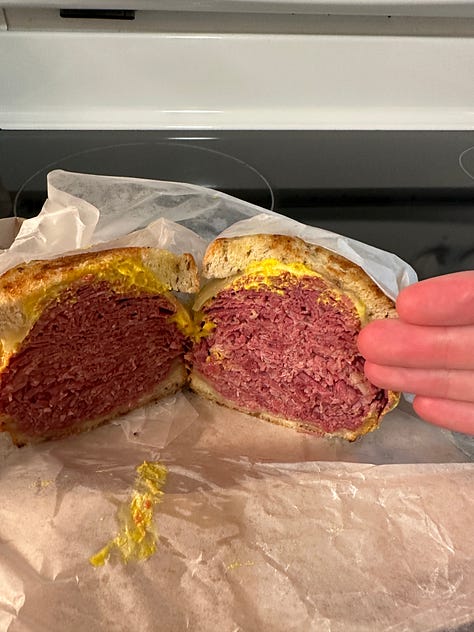
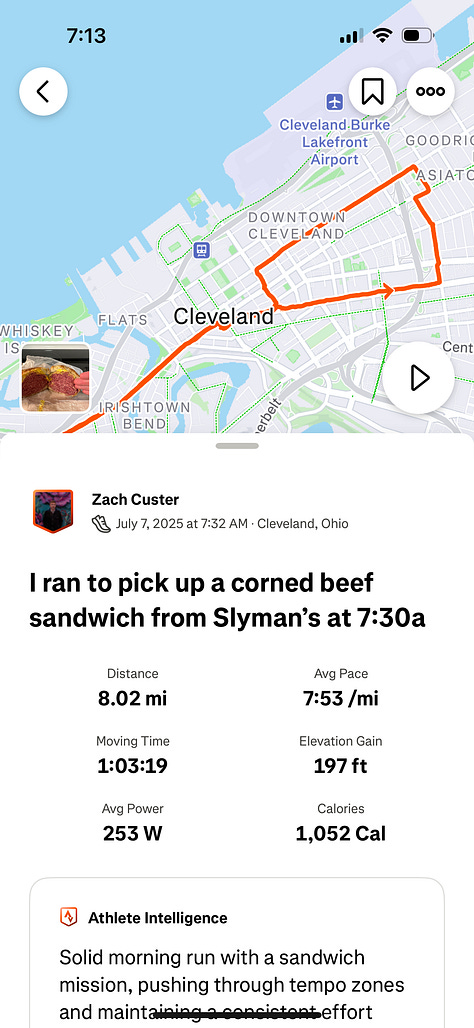
I departed Cleveland on a Monday afternoon, and because I was working remotely that day from coffee shops, I had little time for exploring. But I had yet to visit a Cleveland fixture, one that I could not allow myself to miss — Slyman’s Deli. By the grace of god, they’re open at 7 a.m. Monday through Friday, so I opted to make my morning run one to the deli. It was already 80 degrees and 85% humidity at 8 a.m. when I rolled in sweating and out of place. Despite my appearance, the woman at the counter was happy to help me, and somewhat fascinated by my spectacle. I of course ordered the Corned Beef sandwich on rye, their prized item.
I ran the 4 miles back home with my sandwich, past strip clubs, gas stations, and windowless industrial buildings. My corned beef behemoth, tightly wrapped in paper, bounced around a plastic grocery bag with each stride. The corned beef aroma continually wafted to my face, a confusing sensory experience when on a morning run in the July heat. But one must try the classics, circumstances be damned.
With no other food back at my place this sandwich became my breakfast and I have no regrets. Despite the mountain of corned beef disproportionately outweighing the other ingredients 10:1, the flavors were remarkably coherent. The thinly sliced beef had a way of tenderly melting away, evening out flavors and making the fist-sized meat stack feel more manageable with each bite. It was the right way to end my stay.
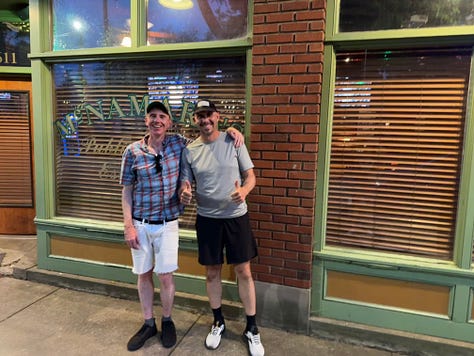
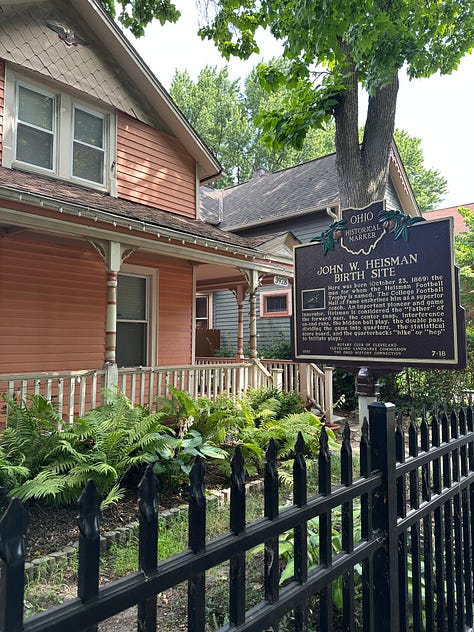
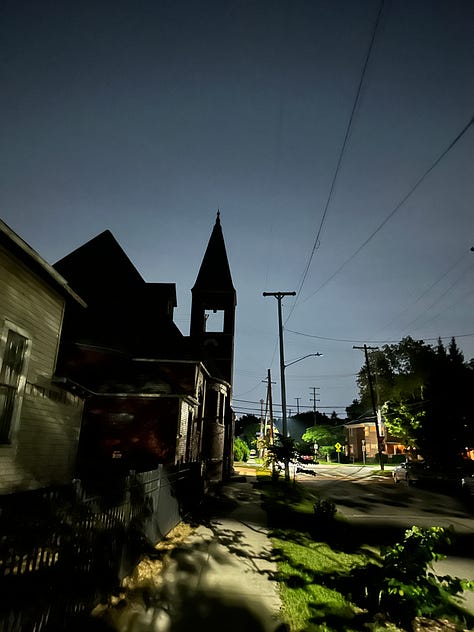

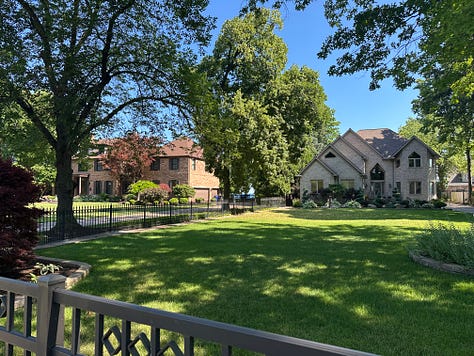

Make no mistake, like other Rust Belt cities, Cleveland has been hollowed out and continues to lose population. The city itself has gone from its 1950’s peak of 915,000, to roughly 365,000. The greater metropolitan area meanwhile has remained relatively flat at just over 2 million. Among a variety of factors and nuance, this is the result of two worlds colliding. The American dream of suburbanization and the interstate highway system meeting the American reality of industrial job loss and divestment. It’s a situation that’s played out in most of the Midwest and Rust Belt.
Yes, Cleveland still has the textbook stretches of desolate streets that are common in our legacy cities. The hip neighborhoods of Tremont and Detroit-Shoreway still felt far from bustling. But in nearly every establishment that I stepped into it was more than just a place, it was a living institution. Cleveland not only preserves these, but they remain local favorites, well trafficked, and eagerly shared with visitors. That cultural guardianship along with the reimagining of the decaying landscape is creating the rebound underway. The people of Cleveland have the love and devotion to do it, and now they have the right city government to fully realize the turnaround. It’s a decades long task, but with the progress from the previous ten years already proving it’s a worthwhile effort, it shouldn’t feel far-fetched. And thanks to the determined pride of Clevelanders, it’s slowly becoming a reality.


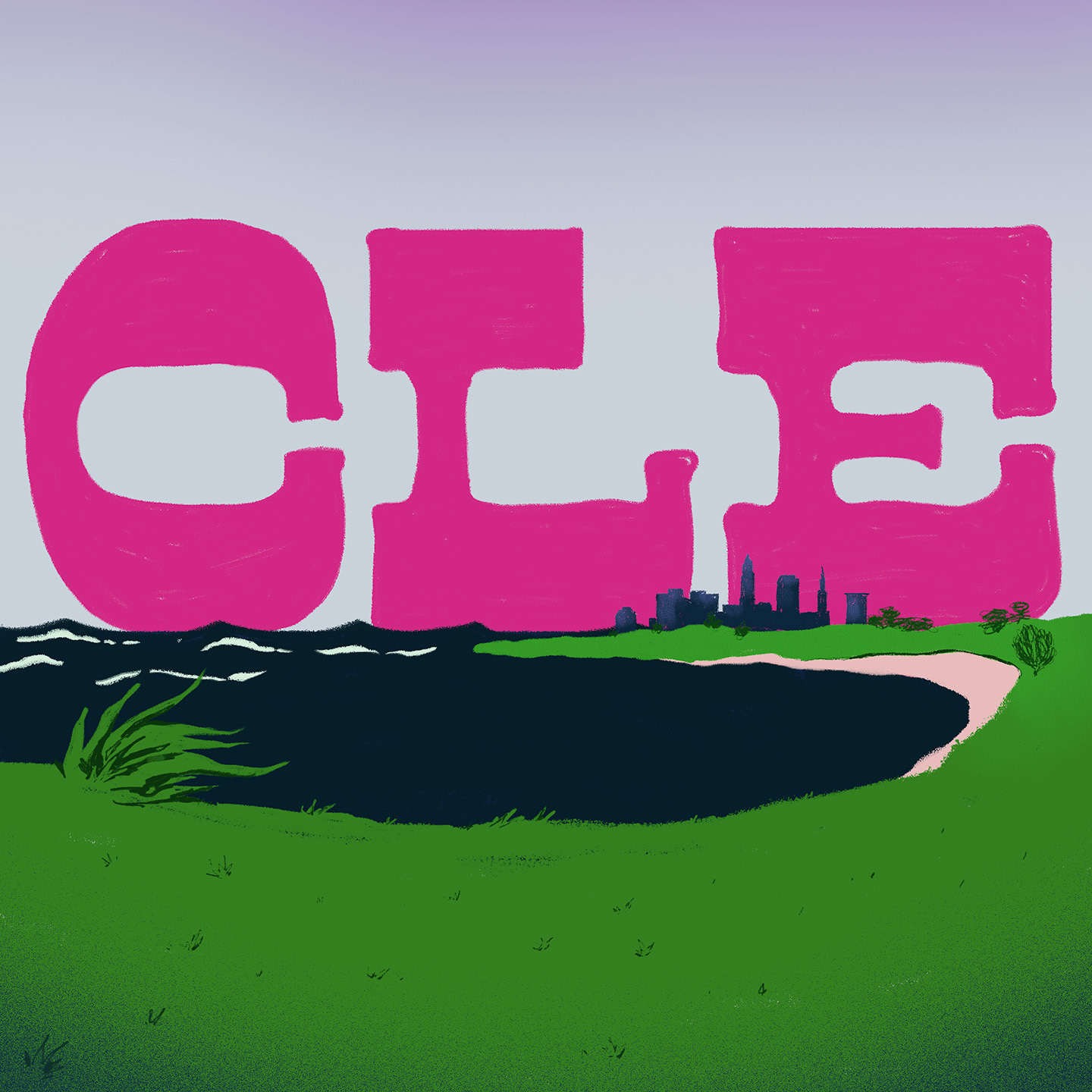
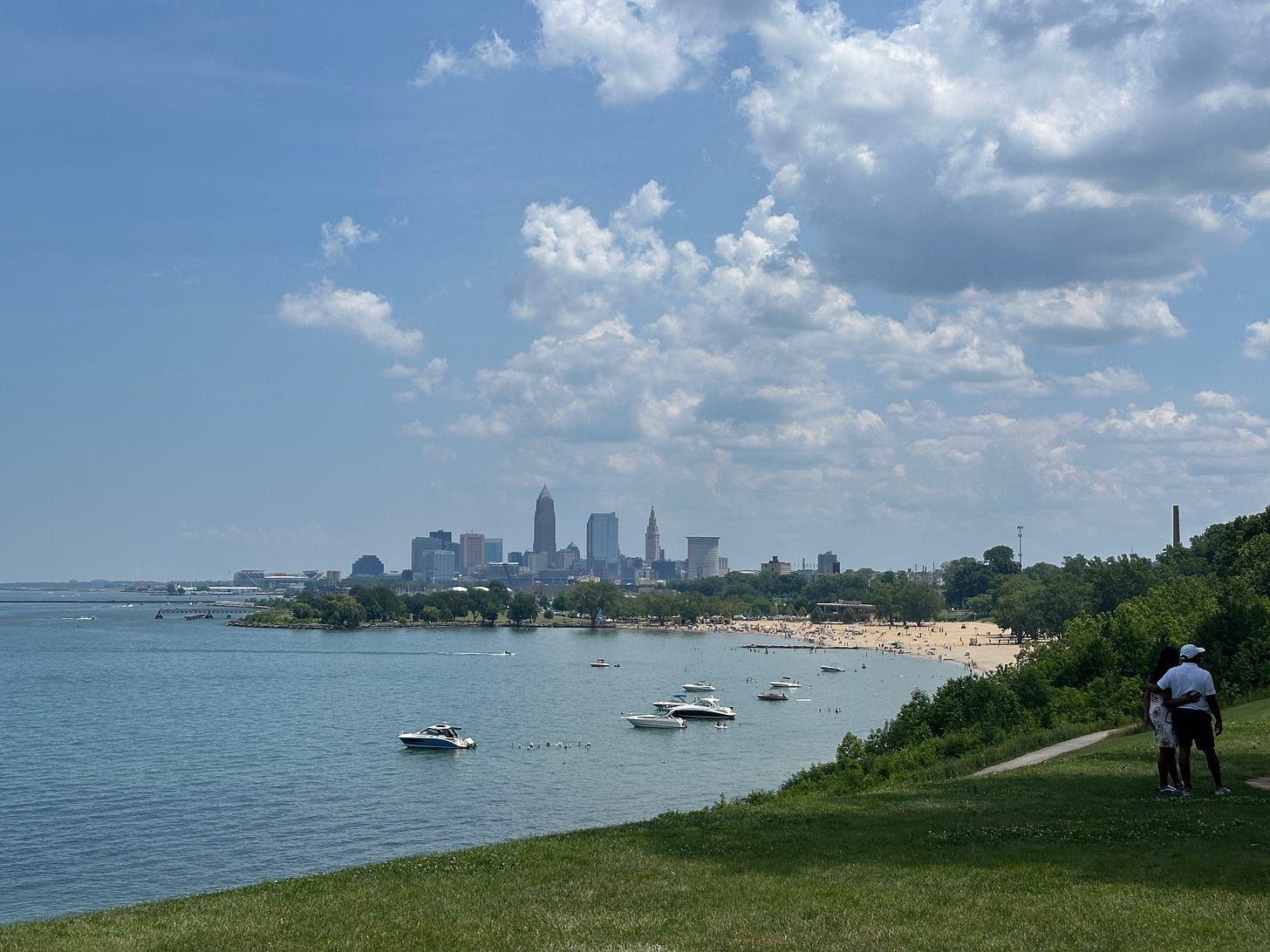
Great piece. As a lifelong native of the area and a current resident of Cleveland city proper, I can say you really captured a lot of the heart of the city.
A few minor clarifications:
* "Population loss is now a trickle not a torrent." Believe it or not now we're now amid a apopulation GAIN, albeit a trickle as you suggest. https://spectrumnews1.com/oh/columbus/news/2025/05/28/cleveland-population-shows-estimated-growth
* Our large body of water is Lake Erie, not Lake Eerie
Sort of wish you'd called your blog Second-Tier Cities rather than Second-Rate Cities with its negative connotation, but nonetheless, keep up the good work.
Huge! Uplifted my spirits massively reading this man, what a write-up. #tubedmeatcapital here we come!